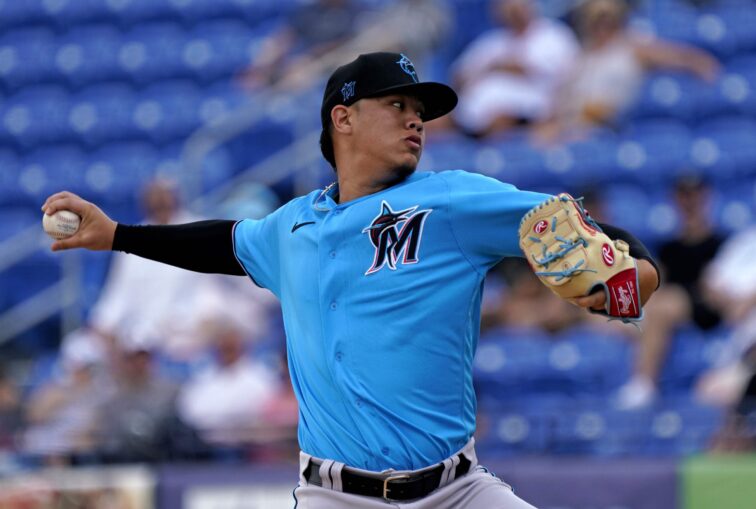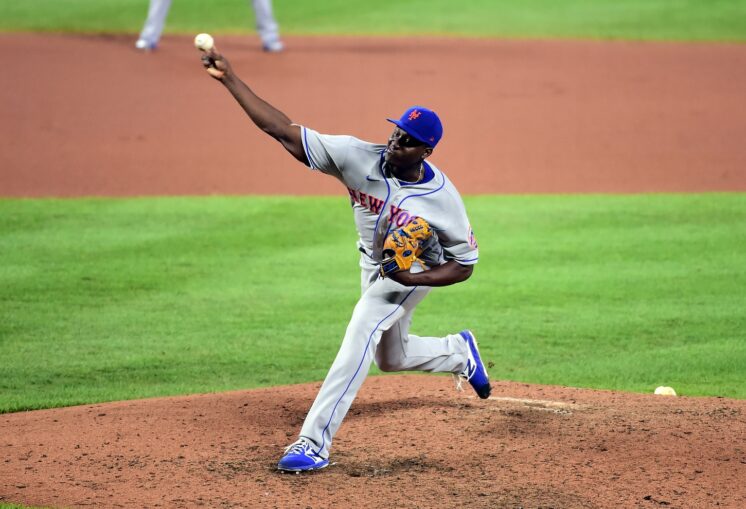
Credit: Steve Mitchell-USA TODAY Sports
Bullpen arms are often considered to be the most volatile position in baseball.
Most relievers never experience long-term dominance, and aside from the great ones, most see their success come in bursts. Relievers seldom see love on top prospect lists, top 100 lists, or anything of that nature. Even more to their unpredictability, most of the bests were failed starters.
Just look at the Mets: Jeurys Familia and Seth Lugo, arguably their two best relievers of the last 10 years, were starters-turned-relievers. With the recent news of Brad Brach being set free and Lugo undergoing surgery, the Mets may need an unexpected name or two to step up.
So the question arises: what in-house options do the Mets have that can step up and find a home in the bullpen?
Jordan Yamamoto
The first option is Jordan Yamamoto. The 24-year-old is entering his third season after debuting for the Marlins in 2019, a season in which he posted a 4.46 ERA with a 1.14 WHIP, 9.4 K/9, and 4.1 BB/9 over 78.1 innings. His 2020, however, was…not good. He. posted an ERA over 16.00, a WHIP that sat at 3.00, and owned a 21.4 H/9, albeit over only 11 innings.
Yamamoto, who has a six-pitch repertoire, could project well out of the bullpen and maybe give them a Seth Lugo lite type pitcher. For Yamamoto, he throws his fastball, cutter and curveball a combined total of 75 percent of the time. As for Lugo, his fastball, curveball, and sinker are thrown, you guessed it, 75 percent of the time.
According to his Savant page, Yamamoto still sat among the best in the league last season in regards to spin rate: his fastball sat in the 83rd percentile and his curveball sat in the 78th percentile. His curveball and sliders sat in elite territory in terms of vertical drop and horizontal movement. His fastball was consistently at an average of 90 mph in 2019, and then a shade below 90 in 2020. His fastball gained some drop on it in 2020, going from 15.4 inches of vertical movement in 2019 to 18.1 inches.
Yamamoto has only averaged five innings per start in his Major League career, showing little ability to go deep into starts. The hope would be that he would be able to take his fastball spin rates, his curveball spin rates and movement, and his slider movement and turn it all into plus makeup out of the bullpen.

Evan Habeeb-USA TODAY Sports
Franklyn Kilomé
Franklyn Kilome, a sinker/curveball specialist, was acquired for Asdrubal Cabrera prior to the 2018 trade deadline. He underwent Tommy John surgery, and after rehabbing in 2019, made his debut in the shortened 2020 season.
The Dominican Republic native throws his sinker, which sits at 94 mph almost 50 percent of the time, and his curveball, which drops an average of 51.1 inches, 28 percent of the time. He also throws a four-seam fastball and changeup, the second of which he threw 18.3 percent of the time, but both pitches saw opponent batting averages sit over .300.
For a quick comparison, let’s look to Jeurys Familia. Familia was promoted to the Mets as a starting pitcher in 2012 after starting 28 games for then Triple-A Buffalo. At the time, Familia predominantly threw a four-seam fastball (48.1 percent), a sinker (31.7 percent), and a slider (15.4 percent).
As time progressed, Familia began to throw his sinker more, his fastball less, and his slider usage stayed relatively consistent. By 2015, arguably his best season in the majors, Familia was throwing his sinker at a 62 percent usage rate, his slider at 23.7 percent, and his fastball at nine percent. He has tried some other pitches over the years (changeup, curveball, splitter), but none of them have really stuck or became a weapon for him.
Kilomé can follow a similar path, if approached correctly. If he can throw his curveball more, which induced a 36 percent whiff rate, cut out the four-seam fastball, and improve upon his changeup with pitching coach Jeremy Hefner and his right hand man Jeremy Accardo, he has potential to become a solid reliever for the Mets with a strong three pitch repertoire. A sinker sitting at 95 mph, A curveball at 82 with 51 inch drop, and a changeup with an above average 31 inch drop, is a solid foundation for the 6’6″ 25 year-old.
However, Kilomé will need to generate more swings and misses and control his pitches better. It is important to note that 2020 was his first in game action since Tommy John, and he did not have a normal rehab from the surgery due to the pause of Spring Training and no minor league season. His minor league track record suggests that his 7.1 BB/9 of last season was a fluke, considering his minor league career BB/9 is 3.7. In his 38 innings in Binghamton in 2018, Kilomé posted a WHIP of 1.07, a BB/9 of 2.4, and a K/9 of 9.9.
A key for Kilomé will be resuming a regular and structured throwing routine while healthy, which he hasn’t been able to have since his Tommy John surgery in late 2018. Kilomé will likely start the season in Syracuse as a part of their rotation, but his best days long-term are likely in the Mets’ bullpen.
Thomas Szapucki
Thomas Szapucki, once one of the more promising left-handed prospects in baseball, has been set back by Tommy John surgery and the non-existent 2020 minor league season. Szapucki was ranked as the 69th best prospect according to Baseball America prior to the 2017 season. However, he underwent Tommy John during the 2017 season.
Still only 24-years-old, Szapucki was placed on the Mets’ 40-man roster prior to the 2020 season to avoid losing him in the Rule V draft. His calling card through the minors was the strikeout, posting a career 11.7 K/9 from the GCL through Double-A Binghamton.
After returning from Tommy John, Szapucki appeared in 21 games, 18 of them being starts, over 61.2 innings. After he began his rehab, Szapucki only made one start longer than five complete innings, and only went into the fifth inning four other times. While the season overall was a success, Szapucki likely profiles as a bullpen arm from here. He posted a 2.63 ERA over the 61.2 innings, and had a WHIP of 1.11, a K/9 of 10.8, and a BB/9 of 4.2.
The Mets lack of left-handed relievers on the 40-man roster causes some concern and makes Szapucki’s path to the majors a little bit clearer. With Aaron Loup, Daniel Zamora and Stephen Tarpley the only other lefty relievers on the 40-man, Szapucki will likely be given a chance to compete for a bullpen spot going into camp, considering the Mets now have two open spots following Brach’s DFA and Lugo’s injury news. His curveball grades as a 60/60 present/future grade from FanGraphs, while his fastball and changeup both sit at 45/50.
Szapucki, who is projected to be Major League ready by 2021, should be ready to go injury wise when camp opens next week, and will should get a good long look by the Mets brass in Port St Lucie.
















